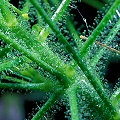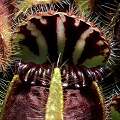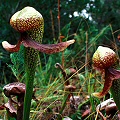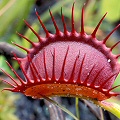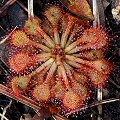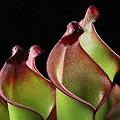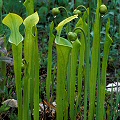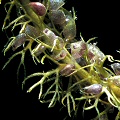| Pinguicula 'Aphrodite' |
Carniv.Pl.Newslett.29:118 (2000)
Details |
CP Photofinder |
Cultivar: Pinguicula 'Aphrodite' J.Flisek & K.Pasek
Publication: Carniv.Pl.Newslett.29:118 (2000) https://legacy.carnivorousplants.org/cpn/articles/CPNv29n4p116_122.pdf
Web Publication: https://legacy.carnivorousplants.org/cpn/Species/v29n4p116_122.html#aphrodite
Comment: priority for parentage
Synonym: =Pinguicula agnata Casper * Pinguicula moctezumae Zamudio Ruiz
Originator: J.Flisek, Frenstat p.R., & K.Pasek, Dobroslavice, Czech Republic, 6. 1998
Nominant: J.Flisek & K.Pasek, 23. 2. 2000
Registrant: J.Flisek & K.Pasek, 23. 2. 2000
Horicultural comment: Registered 29. 1. 2001 {JS}
Standard: Carniv.Pl.Newslett.29:120 (2000)
Propagation: leaf cuttings
Etymology: after the Greek goddess of love and beauty
Description: Carniv.Pl.Newslett.29:118 (2000)
"The cultivar Pinguicula ' Aphrodite ' J.Flisek & K.Pasek is characterized by its very long, narrow leaves with rounded tips which terminate in a point. The summer rosette consists of up to 15 leaves which are up to 12 cm long and 2 cm wide; the leaf-edges roll downwards. The erect leaves display a characteristic, descending-arch along their lengths. Under intense summer sunlight, the leaf-edges of leaves can be reddish, whereas the leaf midribs remain green along their enitre length. During the winter, the rosette size decreases, whilst the number of leaves increases to as many as 25. The leaves of the winter rosette are up to 5-6 cm long and 1.3 cm broad; mostly they are flat and light green. The plants bloom all year round, indeed during the winter the plants can have the most flowers open at the same time. The color and size of the flowers changes as the flowers age. Freshly open flowers are relatively small and are generally dark-violet. As the flowers age they enlarge and fade to pink. When viewed from the proper angle the petals reflect light to give a shiny appearance. The posterior side of the flower is significantly lighter in color. Gentle, faint veining is apparent over the entire surface of the five (very exceptionally six) petals; this venation is more distinct towards the flower center. The entrance to the corolla tube and the tube itself is bright yellow, and minutely hairy. Mature flowers can reach 4 cm in a diameter and this in fact ranks them among the true giants of the Pinguicula L.! The spur of the flower is narrow, slightly bowed and may be up to 1.5 cm long. Flowering time is about four weeks depending on the growing condition. Flower stalks can reach 15 cm in length (exceptionally 22 cm), the upper part of the stalk (about 1-2 cm) can be brownish-red, and the lower part is green and covered with tentacles. The sepals are a rich green color."
|
| Pinguicula 'Ayautla' |
Savage Garden:205 (1998)
Details |
CP Photofinder |
Cultivar: Pinguicula 'Ayautla' D'Amato
Publication: Savage Garden:205 (1998)
Synonym: =Pinguicula gigantea Luhrs
Originator: A.Lau, from S.Bartolome de Ayautla, MX, 1987
Nominant: P.D'Amato
Horicultural comment: name not registered with ICRA (not considered as a cultivar by nominant)
Standard: Savage Garden:206 (1998)
Etymology: after the provenience of the plant
Description: Savage Garden:205 (1998)
"The rosettes are very large, with arching, buttery yellow leaves that are sticky on both their upper and lower surfaces - the only such butterwort yet known. The handsome flowers are tinted violet with a striking purplish edging."
|
| Pinguicula 'Bettie' |
Carniv.Pl.Newslett.39:81 (2010)
Details |
CP Photofinder |
Cultivar: Pinguicula 'Bettie' C.Weinberger
Publication: Carniv.Pl.Newslett.39:81 (2010)
Comment: simultaneous synonym of Pinguicula ' Jannes ' C.Weinberger
Synonym: =Pinguicula debbertiana Speta & Fuchs * Pinguicula cyclosecta Casper
Originator: C.Weinberger, Bueren, DE
Nominant: C.Weinberger
Registrant: C.Weinberger, 27. 6. 2010
Horicultural comment: Registered 4. 10. 2010 {JS}
Standard: Carniv.Pl.Newslett.39:81 (2010)
Description: Carniv.Pl.Newslett.39:81 (2010)
"The flower of Pinguicula ' Bettie ' C.Weinberger is quite different from Pinguicula ' Jannes ' C.Weinberger. The coloration is paler and the corolla lobes are longer, with rounded edges. They are narrower and do not overlap. In the place of the yellow spot of Pinguicula debbertiana Speta & Fuchs there is a white one, but with no or very weak hairiness."
|
| Pinguicula 'Down Under' |
Carniv.Pl.Newslett.37:22 (2008)
Details |
CP Photofinder |
Cultivar: Pinguicula 'Down Under' Kibellis
Publication: Carniv.Pl.Newslett.37:22 (2008)
Comment: priority for parentage
Synonym: =Pinguicula emarginata Zamudio Ruiz & Rzedowski * Pinguicula moctezumae Zamudio Ruiz & R.Z.Ortega
Originator: H.Kibellis, Castle Hill, NSW, AU, 2001
Nominant: H.Kibellis
Registrant: H.Kibellis, 6. 4. 2007
Horicultural comment: Registered 12. 6. 2008 {JS}
Standard: Carniv.Pl.Newslett.37:24 (2008)
Propagation: vegetative
Etymology: after the breeder's adoptive country
Description: Carniv.Pl.Newslett.37:22 (2008)
"Under good conditions the plant has between 10-12 leaves when in active growth. Its leaves are narrowly linear, up to 1cm wide and 6 cm long. They are green-purplish but are dark purple at the base. This leaf colour is present even in a shady situation but the purple colour intensifies in sunnier positions. The outstanding leaf color is a major reason I believe cultivar registration is warranted for this clone.
Flowers are uniformly pale mauve and unscented. The five petals are about 1cm long. The upper petals are about 8 mm wide and 8 mm long (measured from the petal tip to the point of fusion between them). The two lower lateral petals are 6 mm wide and 10 mm long from the tip of the petals to the point where they fuse with the lower central petal. The lower central petal is about 8 mm wide and approximately 12 mm long, measured from its tip to its points of fusion with the lower lateral petals. All the petals are square-tipped and reticulated with darker veins.
The corolla has a cream to yellowish ring extending from the lower part of the corolla up to the apron-like dark purple lobe of the stigma. This ring does not continue above the stigmatic lobe. The spur is 20 mm long, angled approximately 12deg to the pedicel.
The main flowering time is from early spring to early winter, but flowering can occur throughout the year. Each plant may have as many as three flowers blooming at the same time, and they last up to three weeks.
Like both of its parents, Pinguicula ' Down Under ' H.Kibellis responds well to permanently moist to wet conditions."
|
| Pinguicula 'Enigma' |
Carniv.Pl.Newslett.33:88 (2004)
Details |
CP Photofinder |
Cultivar: Pinguicula 'Enigma' T.H.Wyman
Publication: Carniv.Pl.Newslett.33:88 (2004) https://legacy.carnivorousplants.org/cpn/articles/CPNv33n3p83_89.pdf
Web Publication: https://legacy.carnivorousplants.org/cpn/Species/v33n3p83_89.html#enigma
Comment: priority for supposed parentage
Synonym: =?Pinguicula cyclosecta Casper * Pinguicula esseriana B.Kirchner
Originator: Carl Schoenfeld, Yucca Do Nursery, & J.G.Fairey, Peckerwood Garden, USA, from Mexico (no locality given)
Nominant: T.H.Wyman, Stone Mountain, Ga., USA
Registrant: T.H.Wyman, 29. 9. 2003
Horicultural comment: Registered 30. 12. 2004 {JS}
Standard: Carniv.Pl.Newslett.33:87 (2004)
Etymology: because of unknown origin/parentage of the plant
Description: Carniv.Pl.Newslett.33:84 (2004)
"Its spoon-like leaves with upturned margins characterize the carnivorous foliage of this plant. During this phase of growth the rosette consists of up to twenty leaves, which are up to 4 cm long and 1 cm wide at their widest point. Initially the leaves tend to be held at an upright angle, but later they arc down to lay flat. The leaves remain a light green colour, even under intense light. During succulent growth, the size of the rosette decreases and the number of leaves increases to 50 or more. These leaves lack any upturned margins and are covered with sparse fine hair. They are spathulate in shape and up to 2 cm long and 0.75 cm wide. The plants bloom from early spring through summer. Flowers generally occur in pairs and it is not uncommon to have 2-3 pairs open at the same time. The colour of the flowers is lilac with very prominent violet veins and a white throat, and they often have a velvety sheen to them. As with many of the Mexican Pinguicula L. the colour tends to fade slowly as the flowers age. The back of the flower is pale-grey/white in colour and the veining is also prominent. Fully open flowers typically measure 2.5-3 cm in diameter. This plant is easily propagated via leaf cuttings and also has a tendency to divide readily after flowering, forming large clusters."
|
| Pinguicula 'Eye Spy' |
Carniv.Pl.Newslett.49:139 (2020)
Details |
CP Photofinder |
Cultivar: Pinguicula 'Eye Spy' S.Bunclark
Publication: Carniv.Pl.Newslett.49:139 (2020)
Comment: priority for supposed parentage
Synonym: =Pinguicula grandiflora Lam. * ?Pinguicula vallisneriifolia Webb
Originator: S.Bunclark, Norwich, GB, 2011
Nominant: S.Bunclark
Registrant: S.Bunclark, 29. 4. 2020
Horicultural comment: Registered 23. 9. 2020 {JS}
Standard: Carniv.Pl.Newslett.49:139 (2020)
Propagation: vegetative
Etymology: after electric violet petals and a white inset marked with venation which resembles eye lashes
Description: Carniv.Pl.Newslett.49:139 (2020)
"When seed from the parent Pinguicula grandiflora Lam. was germinated, one seedling stood out from the batch with larger features in leaf and a corrugated appearance. This now mature seedling was monitored for several years and displays a most interesting flower with electric violet petals and a white inset marked with venation which resembles eye lashes - hence the name ‘Eye Spy’ (Fig. 1).
Pinguicula 'Eye Spy' S.Bunclark is a cool temperature plant producing multi stages of growth with elongated leaves up to 15 cm long, a starry semi erect shape develops and later in its growth season produces red/purple venation on the leaves, often reducing its surface area to sunlight. More shaded plants will become greener, larger, and less crimpled."
|
| Pinguicula 'Florian' |
Carniv.Pl.Newslett.33:20 (2004)
Details |
CP Photofinder |
Cultivar: Pinguicula 'Florian' O.Gluch
Publication: Carniv.Pl.Newslett.33:20 (2004) https://legacy.carnivorousplants.org/cpn/articles/CPNv33n1p19_22.pdf
Web Publication: https://legacy.carnivorousplants.org/cpn/Species/v33n1p19_22.html#Florian
Comment: priority for parentage
Synonym: =Pinguicula debbertiana Speta & Fuchs * Pinguicula esseriana B.Kirchner
Originator: O.Gluch, Harthausen, DE, 1998
Nominant: O.Gluch
Registrant: O.Gluch, 9. 3. 2003
Horicultural comment: Registered 8. 9. 2004 {JS}
Standard: Carniv.Pl.Newslett.33:22 (2004)
Etymology: after the breeder's eldest son's first name
Description: Carniv.Pl.Newslett.33:20 (2004)
"The hybrid has two different rosette types. The winter rosette consists of up to 100 spatulate, non-carnivorous winter leaves, each up to 2.5 cm long and up to 0.6 cm wide. These are mostly green, but sometimes the leaves can be green with red highlights. The summer leaves are less numerous (up to 25), and are spatulate to obovate in form with the outermost part of the leaf having an upturned margin. The coloration of the leaves is mostly green-brown to green-red. The plants flower mostly when in the winter rosette stage, and produce up to 5-8 flowers per year. The two corolla lips form an angle between 20 and 45 degrees. The two lobes of the upper lip overlap slightly and are spatulate to obovate in form, up to 1.2 cm long and 0.9 cm at the widest point. The three lobes of the lower lip are also spatulate to obovate, up to 1.5 cm long and 0.9 cm at the widest point. The lobes are pink, with darker parallel veins that run from the lobe base into the throat. The proximal palate surface bears two rows of yellow to light green hairs. The corolla tube is short (0.2 cm), with two rows of yellow hairs at its base. The outside of the tube is whitish to pale green, and also bears parallel venation. The (light green) spur can be up to 1.2 cm long and bears brown to reddish venation. All five calyx lobes are obovate, light green and approximately 0.4 cm long. The lower two calyx lobes are almost parallel to each other. The stigmata is ochre. The flower stalk is up to 16 cm long, and bears some glandular hairs near the top."
|
| Pinguicula 'George Sargent' |
Insect-Eat.Pl. & How to Grow Them:113 (1986)
Details |
CP Photofinder |
Cultivar: Pinguicula 'George Sargent' Hort.Slack
Publication: Insect-Eat.Pl. & How to Grow Them:113 (1986)
Comment: priority for parentage
Synonym: =Pinguicula moranensis H.B.K. * Pinguicula gypsicola Brandeg.
Originator: G.A.Sargent, England, before 1986
Nominant: A.Slack
Registrant: A.Slack
Horicultural comment: Registered 10. 11. 1998 {JS}
Standard: Insect-Eat.Pl. & How to Grow Them:114 (1986)
Etymology: after the originator
Description: Insect-Eat.Pl. & How to Grow Them:113 (1986)
"Mr. G.A. Sargent has crossed Pinguicula moranensis var. caudata (Schlecht.) Hort.Slack with Pinguicula gypsicola Brandeg.. The clone he gave me produces numerous rich lilac flowers over curiously bendy, strap-shaped leaves. The winter rosettes are enormous, and at that time they must be kept bone dry. Pinguicula ' Hameln ' Hort.Slack and Pinguicula mitla Hort.Slack are of the Pinguicula gypsicola Brandeg. * Pinguicula moranensis H.B.K. ' Hamburg ' (sic!) cross, and both differ in their wider Pinguicula moranensis H.B.K.-like foliage and in not producing the large winter rosettes of Pinguicula ' George Sargent ' Hort.Slack."
|
| Pinguicula 'Giant Green Violet' |
Carniv.Pl.Newslett.42:67 (2013)
Details |
CP Photofinder |
Cultivar: Pinguicula 'Giant Green Violet' J.H.Lee
Publication: Carniv.Pl.Newslett.42:67 (2013)
Comment: later synonym of Pinguicula ' Tina ' Hort.Slack
Synonym: =Pinguicula zecheri Speta & Fuchs * Pinguicula agnata Casper
Originator: J.H.Lee, Seoul, KR, 2007
Nominant: J.H.Lee, 14. 1. 2013
Registrant: J.H.Lee, 5. 2. 2013
Horicultural comment: Registered 30. 6. 2013 {JS}
Standard: Carniv.Pl.Newslett.42:67 (2013)
Propagation: asexually only
Etymology: after size of plant and colouration of leaves and flowers
Description: Carniv.Pl.Newslett.42:67 (2013)
"This cultivar usually grows much faster and healthier in wet soil than in dry soil.
The color of the flower is light violet and a violet vein on the petals has irregular patterns (Fig. 2). Sometimes petals can be fused or grow in an unusual, overlapped, or dislocated form. The petals are 2-3 cm long and 1.5-2 cm wide. The 10-cm flower stalk is brown and is usually stretched forward. The spur is 5-8 mm long, is entirely green, and grows in a curved shape.
The mostly green leaves are 7-9 cm long and about 4 cm wide and do not become red in strong sunlight. On old leaves, a portion of the vein will have some brown color."
|
| Pinguicula 'Gina' |
Carniv.Pl.Newslett.21:6 (1992)
Details |
CP Photofinder |
Cultivar: Pinguicula 'Gina' Studnicka
Publication: Carniv.Pl.Newslett.21:6 (1992) https://legacy.carnivorousplants.org/cpn/articles/CPNv21n1p6.pdf
Web Publication: https://legacy.carnivorousplants.org/cpn/Species/v21n1p6.html
Comment: later synonym of Pinguicula ' Tina ' Hort.Slack
Synonym: =Pinguicula zecheri Speta & Fuchs * Pinguicula agnata Casper
Originator: M.Studnicka, Botanic Gardens, 46001 Liberec, Czechia, 1985
Nominant: M.Studnicka, 1991
Registrant: M.Studnicka
Horicultural comment: Registered 10. 11. 1998 {JS}
Standard: Carniv.Pl.Newslett.21:6 (1992)
Propagation: vegetative only (in vitro, leaf cuttings)
Etymology: after Gina N., the originator's colleague
Description: Carniv.Pl.Newslett.21:6 (1992)
"The winter rosette is similar to the one of Pinguicula agnata Casper. the summer rosette, consisting of +/- 13 leaves 8 by 6 cm, measures about 15 cm across. These leaves also resemble Pinguicula agnata Casper, but they are a little rolled up on the margins. Flowers are produced by the winter as well as by the summer rosette. The corolla consists of two lips (bilabiate) and it measures 38 by 33 mm. The corolla tube is 10 mm long. The greenish-yellow spur is 17 mm long. These both are glandular haired and they contain an angle 140 deg. There are three differently coloured zones from the margins to the centre of the corolla, as seen in the photo. The mouth of the corolla, as seen in the marked by a yellow band. The stigma violet in the center and white in the margins. The hybrid cannot produce any seeds. It is propagated by means of culture "in vitro" in the Botanic Gardens in Liberec (Czechoslovakia)."
|
| Pinguicula 'Hameln' |
Insect-Eat.Pl. & How to Grow Them:113 (1986)
Details |
CP Photofinder |
Cultivar: Pinguicula 'Hameln' Hort.Slack
Publication: Insect-Eat.Pl. & How to Grow Them:113 (1986)
Comment: synonym of Pinguicula mola Powell but latter name not published validly
Synonym: =Pinguicula gypsicola Brandeg. * Pinguicula moranensis H.B.K.
Originator: H.Weiner, Hameln, Germany, 1981
Nominant: H.Weiner
Registrant: A.Slack
Horicultural comment: Registered 9. 10. 2002 {JS}
Standard: direct submission {Pierre Gelinaud}
Etymology: after the originator's locality
IMAGE: http://omnisterra.com/botany/cp/pictures/pinguicu/molla11.htm Standard Photo
Description: Insect-Eat.Pl. & How to Grow Them:113 (1986)
"Mr. G.A. Sargent has crossed Pinguicula moranensis var. caudata (Schlecht.) Hort.Slack with Pinguicula gypsicola Brandeg.. The clone he gave me produces numerous rich lilac flowers over curiously bendy, strap-shaped leaves. The winter rosettes are enormous, and at that time they must be kept bone dry. Pinguicula ' Hameln ' Hort.Slack and Pinguicula mitla Hort.Slack are of the Pinguicula gypsicola Brandeg. * Pinguicula moranensis H.B.K. ' Hamburg ' (sic!) cross, and both differ in their wider Pinguicula moranensis H.B.K.-like foliage and in not producing the large winter rosettes of Pinguicula ' George Sargent ' Hort.Slack."
|
| Pinguicula 'Hanka' |
Carniv.Pl.Newslett.29:46 (2000)
Details |
CP Photofinder |
Cultivar: Pinguicula 'Hanka' Studnicka
Publication: Carniv.Pl.Newslett.29:46 (2000) https://legacy.carnivorousplants.org/cpn/articles/CPNv29n2p46_48.pdf
Web Publication: https://legacy.carnivorousplants.org/cpn/Species/v29n2p46_48.html#hanka
Comment: priority for parentage
Synonym: =Pinguicula zecheri Speta & Fuchs * Pinguicula rotundiflora Studnicka
Originator: M.Studnicka, Botanic Garden Liberec, Czech Republic, 1990
Nominant: M.Studnicka, 1992
Registrant: M.Studnicka, 25. 11. 1999
Horicultural comment: Registered 4. 7. 2000 {JS}
Standard: Carniv.Pl.Newslett.29:48 (2000)
Propagation: vegetative
Etymology: after originator's daughter Hana P.
Description: Carniv.Pl.Newslett.29:46 (2000)
"The selected cultivated variety (...) forms a winter succulent rosette and a summer carnivorous one, both relatively small and rather brown-coloured when grown in sunny sites. The winter rosette, consisting of about 50 drop-shaped leaves, measures about 27 mm across. The summer rosette, consisting of 10 to 18 leaves, measures about 45 mm across. Its leaves are spathulate, membranous, turned upwards in the margins. Flowers are produced at any time, by both the winter and the summer rosettes, but most frequently in November. Flower stalks are about 55 mm high. The corolla is subisolobous, is oval in outline when viewed from the front, and measures up to 30 by 27 mm. The wide corolla lobes touch or cover each other in the margins. They are corrugated and slightly emarginate. The corolla is lilac, darker reticulated, with a yellowish stripe in the middle lobe of the lower lip. The corolla tube is 4 mm long. The bluntly pointed spur is 8 mm long, bent towards the lower lip. The calyx consists of narrow, about 2.5 mm long lobes, rounded at the tip. The calyx, the corolla tube, the spur and the flower stalk are endowed with glandular hairs. The stigma is purple, corrugated, with long hairs in the reverse side. The plant is sterile. Its minor capsule measures 1 mm, and it is spherical, dark green, with sessile glands on the surface. Pinguicula ' Hanka ' Studnicka may be propagated easily by means of leaf cuttings made from the numerous winter leaves."
|
| Pinguicula 'Huahuapan' |
Insect-Eat.Pl. & How to Grow Them:110 (1986)
Details |
CP Photofinder |
Cultivar: Pinguicula 'Huahuapan' Hort.Slack
Publication: Insect-Eat.Pl. & How to Grow Them:110 (1986)
Synonym: =Pinguicula moranensis H.B.K.
Originator: A.Slack, from Huahuapan, Mexico
Nominant: A.Slack
Registrant: A.Slack
Horicultural comment: Registered 10. 11. 1998 {JS}
Standard: Insect-Eat.Pl. & How to Grow Them:110 (1986)
Etymology: after the locality from which the plants were collected
IMAGE: http://omnisterra.com/botany/cp/pictures/pinguicu/loyd37.htm plant with flower
Description: Insect-Eat.Pl. & How to Grow Them:110 (1986)
"(...) Thus, in Pinguicula ' Mitla ' Hort.Slack the purplish to carmine pink (corolla) lobes are so narrow as to give a spidery appearance; they are rather less so in Pinguicula ' Huahuapan ' Hort.Slack, and of lilac pink with crimson touches at their base. In Pinguicula ' Vera Cruz ' Hort.Slack the flower is of similar form to Pinguicula moranensis var. caudata (Schlecht.) Hort.Slack, but it is of deep rose with more substantial basal marking."
|
| Pinguicula 'Jannes' |
Carniv.Pl.Newslett.39:80 (2010)
Details |
CP Photofinder |
Cultivar: Pinguicula 'Jannes' C.Weinberger
Publication: Carniv.Pl.Newslett.39:80 (2010)
Comment: simultaneous synonym of Pinguicula ' Bettie ' C.Weinberger
Synonym: =Pinguicula debbertiana Speta & Fuchs * Pinguicula cyclosecta Casper
Originator: C.Weinberger, Bueren, DE
Nominant: C.Weinberger
Registrant: C.Weinberger, 27. 6. 2010
Horicultural comment: Registered 4. 10. 2010 {JS}
Standard: Carniv.Pl.Newslett.39:81 (2010)
Description: Carniv.Pl.Newslett.39:80 (2010)
"The flower of Pinguicula ' Jannes ' C.Weinberger is more similar to Pinguicula cyclosecta Casper. The upper corolla lip consists of two round lobes; the lower lip has three round lobes that overlap partially. The color is identical to Pinguicula cyclosecta Casper, perhaps a little more purple. The veins are darker and go from the throat up to the tips of the lobes and can also be seen on the spur. The throat has a white, somewhat greenish coloration and has some veins. The typical yellow hairs of Pinguicula debbertiana Speta & Fuchs are present, but not as clearly distinct as in this species."
|
| Pinguicula 'Johanna' |
Carniv.Pl.Newslett.39:117 (2010)
Details |
CP Photofinder |
Cultivar: Pinguicula 'Johanna' C.Weinberger
Publication: Carniv.Pl.Newslett.39:117 (2010)
Comment: priority for parentage
Synonym: =Pinguicula agnata Casper * Pinguicula debbertiana Speta & Fuchs
Originator: C.Weinberger, Bueren, DE
Nominant: C.Weinberger
Registrant: C.Weinberger, 21. 8. 2010
Horicultural comment: Registered 29. 12. 2010 {JS}
Standard: Carniv.Pl.Newslett.39:117 (2010)
Etymology: after originator's relative
Description: Carniv.Pl.Newslett.39:117 (2010)
"The plant itself is heterophyllous, which in summer has about 25 round leaves (up to 4 cm) that overlap partially, while in winter has about 40 leaves with a length of 2-3 cm. The amount of light on a south facing windowsill is enough to color the plant a nice orange-red. With poor lighting the leaves are green like in the parents. Summer rosette is about 9 cm in diameter; winter rosette is smaller about 4-5 cm.
The flower has two upper and three lower petals (which do not overlap) and has a total size of about 2 cm. Flowering is between March and May, during which 3-6 flowers are typically produced. The color is a light purple, very close to Pinguicula debbertiana Speta & Fuchs and gets darker in the middle of the flower. The throat instead is nearly white and shows a venation like Pinguicula debbertiana Speta & Fuchs. Venation is strong in the middle of the flower and becomes hard to see on the outer petal. Like Pinguicula agnata Casper, the hybrid flower has a strong pubescence, especially on the lower petals and where Pinguicula debbertiana Speta & Fuchs has its typical "yellow brush". The "brush" itself is weakly developed with a white-yellow color."
|
| Pinguicula 'John Rizzi' |
Savage Garden:212 (1998)
Details |
CP Photofinder |
Cultivar: Pinguicula 'John Rizzi' D'Amato
Publication: Savage Garden:212 (1998)
Synonym: =Pinguicula moranensis H.B.K. * Pinguicula ?
Originator: P.D'Amato & J.Rizzi
Nominant: P.D'Amato
Horicultural comment: Registered 11. 6. 1999 {JS}
Standard: Savage Garden:212 (1998)
Etymology: after the breeder of the plant
Description: Savage Garden:213 (1998)
"Its exceptionally large, full blooms of deep pink petals warranted its preservation. The oval sumer leaves are undulating and virtually marginless."
|
| Pinguicula 'L'Hautil' |
Internat.Pinguicula Stud.Group Newslett.3:8 (1993)
Details |
CP Photofinder |
Cultivar: Pinguicula 'L'Hautil' L.Legendre & S.Lavayssiere
Publication: Internat.Pinguicula Stud.Group Newslett.3:8 (1993)
Comment: later synonym of Pinguicula ' Sethos ' Hort.Slack and Pinguicula ' Weser ' Hort.Slack
Synonym: =Pinguicula ehlersiae Speta & Fuchs * Pinguicula moranensis H.B.K. * Pinguicula moranensis H.B.K.
Originator: L.Legendre, L'Hautil, 1991
Nominant: L.Legendre & S.Lavayssiere
Registrant: L.Legendre & S.Lavayssiere
Horicultural comment: Registered 10. 11. 1998 {JS}
Standard: {Laurent Legendre}
Propagation: vegetative division
Etymology: after the place of origin of the artificial hybrid
IMAGE: http://omnisterra.com/botany/cp/pictures/pinguicu/hautil.htm Standard photo
IMAGE: http://omnisterra.com/botany/cp/pictures/pinguicu/lhautil.htm Standard photo
Description: IPSG Newslett.3:8 (1993)
"The leaf rosettes of both forms (two different clones of the same parentage considered as one cultivar) are relatively similar, except in size. It is therefore very natural to call one "grande forme" (sic!) (large form) and the other one, wouldn't you have guessed? "petite forme" (sic!) (small form). The heritage from both parents is straightforward. While the summer rosettes are the exact copy of those of Pinguicula ' Sethos ' Hort.Slack, the winter rosettes are very compact like Pinguicula ' Huahuapan ' Hort.Slack. The plants bloom without any surprise at the end of winter. In early blooming stages they have a striking resemblance to the picture by Adrian Slack in his book "Indect Eating Plants", page 110 ( Pinguicula ' Huahuapan ' Hort.Slack). Any similarity disappears when the blooms open. Though the flowers of Pinguicula ' L'Hautil ' L.Legendre & S.Lavayssiere 'Petite Forme' (sic!) resemble the ones of Pinguicula ' Sethos ' Hort.Slack, the flowers of 'Grande Forme' (sic!) consist of very large petals, partially overlapping. In both cases, the petals are slightly undulating, a heritage of Pinguicula ' Huahuapan ' Hort.Slack. The flowers of both forms display identical sets of colours. Their central core is light green. It gives rise to a white spot of 5 by 2 mm on the lower central petal. The central region of the base of both lateral lower petals is marked by two central white lines, 3-4 mm long, which are framed by dark violet lines. The rest of the petals are of a lighter, but still profound, violet colouration. The upper petals are characterised by the same violet tint, though they lack the white spots. The spur, 3 cm long, is almost straight, bending only slightly towards the floor. Tn the case of 'Grande forme', the flower is 3 cm high as well as wide. In 'Petite Forme' it is only 2 cm high and slightly less in width. Both forms bloom generously so that one can expect 2-4 consecutive flowers each year. Since both hybrids divide vegetatively while blooming, beautiful specimens having large floral displays can easily be obtained within a few years."
|
| Pinguicula 'Libelulita' |
Carniv.Pl.Newslett.31:83 (2002)
Details |
CP Photofinder |
Cultivar: Pinguicula 'Libelulita' Rice & Salvia
Publication: Carniv.Pl.Newslett.31:83 (2002) https://legacy.carnivorousplants.org/cpn/articles/CPNv31n3p83.pdf
Web Publication: https://legacy.carnivorousplants.org/cpn/Species/v31n3p83.html
Synonym: =Pinguicula moranensis H.B.K.
Originator: Botanical Conservatory at the University of California, Davis, USA, 1998, from S Mexico
Nominant: E.Salvia, Davis, USA, 18. 10. 2000
Registrant: B.Rice & E.Salvia, Davis, USA, 22. 4. 2002
Horicultural comment: Registered 1. 4. 2003 {JS}
Standard: Carniv.Pl.Newslett.31:95 (2002)
Propagation: by vegetative means
Etymology: little dragonfly (Spanish)
Description: Carniv.Pl.Newslett.31:83 (2002)
"This plant has already been mentioned in the pages of this journal (Carniv.Pl.Newslett.29:55, 2000), when one of us (BMR) reported on how the only specimen we had of this plant nearly rotted to extinction.
In foliage, Pinguicula ' Libelulita ' Rice & Salvia is not particularly different from any of the other many clones of Pinguicula L. in cultivation, but in flower it is so striking that some horticulturists have remarked that it nearly appears to be a new species.
The five petals are large and square-tipped. They are overall pink-purple, deeper so on the distal 2/3rds, and pale to near-white closer to the petal bases. Where the petals fuse, they suddenly darken to a deep velvet red, marked with a few white streaks on the lower-most petal. For us, the most amazing feature of this cultivar is the bold petal venation. This venation reminds one of us in particular (EMS) of the reticulated network of veins visible in the transparent wings of dragonflies."
|
| Pinguicula 'Mitla' |
Insect-Eat.Pl. & How to Grow Them:110 (1986)
Details |
CP Photofinder |
Cultivar: Pinguicula 'Mitla' Hort.Slack
Publication: Insect-Eat.Pl. & How to Grow Them:110 (1986)
Synonym: =Pinguicula moranensis H.B.K.
Originator: A.Slack, from Mitla, Mexico
Nominant: A.Slack
Registrant: A.Slack
Horicultural comment: homonym of [Pinguicula mitla {Hort.Slack}], which is not considered to correspond to the cultivar by author (violating Art.19.6., ICNCP)
Etymology: after the locality from which the plants were collected
Description: Insect-Eat.Pl. & How to Grow Them:110 (1986)
"(...) Thus, in Pinguicula ' Mitla ' Hort.Slack the purplish to carmine pink (corolla) lobes are so narrow as to give a spidery appearance; they are rather less so in Pinguicula ' Huahuapan ' Hort.Slack, and of lilac pink with crimson touches at their base. In Pinguicula ' Vera Cruz ' Hort.Slack the flower is of similar form to Pinguicula moranensis var. caudata (Schlecht.) Hort.Slack, but it is of deep rose with more substantial basal marking."
|
| Pinguicula 'Niklas' |
Carniv.Pl.Newslett.45:161 (2016)
Details |
CP Photofinder |
Cultivar: Pinguicula 'Niklas' O.Gluch
Publication: Carniv.Pl.Newslett.45:161 (2016)
Comment: priority for parentage
Synonym: =Pinguicula moranensis H.B.K. * Pinguicula emarginata Zamudio Ruiz & Rzedowski
Originator: O.Gluch, Harthausen, DE, 2014
Nominant: O.Gluch
Registrant: O.Gluch, 15. 7. 2016
Horicultural comment: Registered 27. 1. 2017 {JS}
Standard: Carniv.Pl.Newslett.45:161 (2016)
Propagation: vegetative
Etymology: after originator's son
Description: Carniv.Pl.Newslett.45:161 (2016)
"The cultivar forms a winter and a summer rosette. The winter rosette consists of 10-15 succulent obovate-spathulate leaves, slightly pointed at the tip, glabrous, of a light green color, 9-12 mm long and 5-7 mm at the widest point. The summer rosette (Fig. 4) consists of 7-9 leaves, obovate-spath- ulate, with the margin involute, light yellow-green to red-green (depending on light conditions), 25-37 mm long, 15-20 mm at the widest point, the upper surface densely covered with sessile and stipitate hairs.
Flowers are produced out of the summer rosette, with 1-3 flower scapes per season, erect, 70-75 mm long, olive or olive-red, densely covered with stipitate glandular hairs. Flowers are about 25 mm long (including the spur), the corolla is about 2 cm in diameter (Fig. 4). The calyx bilabiate, red-brown, with calyx lobes cuneate-linear, 2.5-3 mm long and 1-1.5 mm wide, rounded or obtuse at the tip, the outer surface sparsely clothed in stipitate glandular hairs. The corolla consists of two lips. The 2 lobes of the upper lip are truncate with the end of the lobe slightly incised. Corolla lobes are of a purple-violet color with fine, darker violet venation. The lobes of the upper lip are 9-10 mm long, 6 mm at the widest point, side lobes of the lower lip 9-10 mm long, 6-7 mm at the widest point, middle lobe of the lower lip 13-15 mm long, 9-10 mm at the widest point. The spur is of a light green color, about 17-18 mm long, in the middle slightly thicker, obtuse at the end and densely covered with stipitate glandular hairs."
|
| Pinguicula 'Pale Flower' |
Savage Garden:205 (1998)
Details |
CP Photofinder |
Cultivar: Pinguicula 'Pale Flower' D'Amato
Publication: Savage Garden:205 (1998)
Synonym: =Pinguicula agnata Casper
Originator: P.D'Amato
Nominant: P.D'Amato
Horicultural comment: Registered 11. 6. 1999 {JS}
Standard: Savage Garden:206 (1998)
Etymology: after the colour of the flower
Description: Savage Garden:205 (1998)
"A variety known as Pinguicula ' Pale Flower ' D'Amato has petals almost pure white, with only the slightest hint of purple around the yellowish throat."
|
| Pinguicula 'Pirouette' |
Carniv.Pl.Newslett.29:17 (2000)
Details |
CP Photofinder |
Cultivar: Pinguicula 'Pirouette' J.Brittnacher, B.Rice & L.Song
Publication: Carniv.Pl.Newslett.29:17 (2000) https://legacy.carnivorousplants.org/cpn/articles/CPNv29n1p14_21.pdf
Web Publication: https://legacy.carnivorousplants.org/cpn/Species/v29n1p14_21.html#pirouette
Comment: priority for parentage
Synonym: =Pinguicula agnata Casper * Pinguicula moranensis H.B.K * Pinguicula ehlersiae Speta & Fuchs
Originator: L.Song, Jr., ?1986
Nominant: J.Brittnacher, 2. 10. 1999
Registrant: B.Rice, Davis, USA, 20. 10. 1999
Horicultural comment: Registered 30. 3. 2000 {JS}
Standard: Carniv.Pl.Newslett.29:18 (2000)
Propagation: vegetative only
Etymology: because of the ruffled, delicate leaves reminiscent of a swirling ballerina
Description: Carniv.Pl.Newslett.29:17 (2000)
"Resulting from a cross made 14 October 1986, this plant has proven itself to be forgiving of cultivation errors and resilient to adverse growing conditions. Its flowers are attractive and clear pink, similar in general plan to Pinguicula moranensis H.B.K. but with more rounded petals, akin to those of Pinguicula agnata Casper. Mature plants are about 7 cm. in diameter and may produce a few blooms each year. It is the leaves that are the most striking feature of this plant - it has inherited the opalescent pinky-white foliage of Pinguicula ehlersiae Speta & Fuchs. In some growing conditions Pinguicula ' Pirouette ' J.Brittnacher, B.Rice & L.Song becomes so suffused with rich-pink or even red it looks remarkably like a chlorophyll-free saprophyte one might encounter deep in pine woods! Under moderate light, the leaves are very pale pink with a touch of light green. The leaves this plant produces during the dormant season are smaller and more succulent. Leaf cuttings are best taken with these leaves just before or as the summer leaves begin to emerge. The leaf cuttings root easily. This plant should not be propagated by seed if you wish to maintain the cultivar name attached to it. Its good looks and easy cultivation make Pinguicula ' Pirouette ' J.Brittnacher, B.Rice & L.Song an excellent beginners plant. If you want to try a carnivore on your windowsill, this might be the one to start with!"
|
| Pinguicula 'Razzberry Blonde' |
Carniv.Pl.Newslett.49:90 (2020)
Details |
CP Photofinder |
Cultivar: Pinguicula 'Razzberry Blonde' M.Rubnitz
Publication: Carniv.Pl.Newslett.49:90 (2020)
Comment: ? later synonym of Pinguicula 'Riva' M.Rubnitz
Synonym: =?Pinguicula gigantea Luhrs * Pinguicula emarginata Zamudio-Ruiz & Rzedowski * Pinguicula agnata Casper
Originator: M.Rubnitz, San Francisco, Calif., US, late 2017
Nominant: M.Rubnitz
Registrant: M.Rubnitz, 5. 2. 2020
Horicultural comment: Registered 19. 6. 2020 {JS}
Standard: Carniv.Pl.Newslett.49:53 (front cover) & 90 (2020)
Propagation: vegetative
Etymology: named for its flowers' color palette
Description: Carniv.Pl.Newslett.49:90 (2020)
"This particular plant distinguished itself after about 2 years of growth under lights when it began flowering. The flower is approx. 2.5 cm wide by 3.5 cm long and is a light creamy yellow with a bright raspberry red center and connected fairly heavy outward reaching veining (Fig. 4, Front Cover). The petals are 1.5 cm in length, 1 cm in width, very slightly ruffled and the top 2 petals have irregularly very mildly serrated upper margins. The spur is 1 cm long, very pale yellow-green and slightly curves downward. The stalk of the flower is approx. 15 cm in length. The flowers have so far not produced pollen or seed. The leaves of the plant are nice as well, approx. 4.5 cm in length and approx. 2 cm in width. The leaf is oblong egg shaped with the rounded end distal from the central growth point. The color of the leaves ranges from pale muted rose pink to deep mauve with light beige-green undertones when exposed to higher light intensity or sun. The margins of the leaf are slightly upturned. The rosette may have anywhere from 5-8 leaves at a time. The plant produces dormant semi-succulent leaves. Plants can be propagated easily from pulling either type of leaf. The plant divides itself readily and produces numerous (2-4) flowers at the same time."
|
| Pinguicula 'Red Starfish' |
Carniv.Pl.Newslett.45:162 (2016)
Details |
CP Photofinder |
Cultivar: Pinguicula 'Red Starfish' M.Srba
Publication: Carniv.Pl.Newslett.45:162 (2016)
Comment: priority for parentage
Synonym: =Pinguicula moranensis H.B.K. * Pinguicula heterophylla Benth.
Originator: Botanical Garden Liberec, CZ, 1994
Nominant: M.Srba, Horakov, CZ, 1997
Registrant: M.Srba, 29. 7. 2016
Horicultural comment: Registered 27. 1. 2017 {JS}
Standard: Carniv.Pl.Newslett.45:162&168 (back cover) (2016)
Propagation: vegetative, especially by winter (bulb) leaf cuttings
Etymology: after reminiscence of plant to dangerous predator of tropical coral reefs
Description: Carniv.Pl.Newslett.45:162 (2016)
"Pinguicula ' Red Starfish ' M.Srba (Fig. 5 & Back Cover) provides an unusual look that is much more "carnivorous" compared to other Pinguicula L. species or established cultivars. (...) This clone was selected in 1997 with a special emphasis on the flower color.
Summer leaf rosette is usually 6-9 cm in diameter and consists of 12-20 leaves. Leaves are lanceolate, rolled downwards in lateral as well as in tangential direction. Well-illuminated plants turn into a red-purple coloration. Winter rosette is bulbous, predominantly submerged, and similar to Pinguicula heterophylla Benth.. Winter "bulb" of juvenile plants is fusiform, in mature plants almost globose, consisting of 40-70 leaves. Pinguicula ' Red Starfish ' M.Srba flowers in the beginning of the vegetative season, just after waking from the dormant period. Flowers are sterile. Corolla is dark blue-purple, resembling Pinguicula heterophylla Benth. in shape. Petals are slightly twisted. Size of the flowers is 18-22 mm. Spoon spur is straight, about 20 mm long. Flower stalk is 9-13 cm tall.
Sufficient growth conditions for Pinguicula ' Red Starfish ' M.Srba are the same as in other Mexican Pinguicula L. species strictly undergoing dry winter dormancy like e.g. Pinguicula gypsicola Brandeg., Pinguicula heterophylla Benth., or Pinguicula medusina Zamudio Ruiz & Studnicka. Although it doesn't exhibit any specific growing requirements, we would like to provide several tips to optimize growth of this cultivar. During the first years of our experience, it seemed that Pinguicula ' Red Starfish ' M.Srba is not very floriferous. Later we realized, that the growth period of this clone is very long, lasting until November or even December in conditions of central Europe. If the growth activity is rapidly interrupted by low temperatures or rapid drought, the fitness of dormant plants is significantly decreased. On the other hand, if mild temperatures (8-18 degC) and slightly wet soil is provided during the phenophase transition (beginning of dormancy), the winter bulbs get much stronger. Specimens that formed bulb at least 10 mm wide bloom regularly with 1-3 flowers."
|
| Pinguicula 'Riva' |
Carniv.Pl.Newslett.47:74 (2018)
Details |
CP Photofinder |
Cultivar: Pinguicula 'Riva' M.Rubnitz
Publication: Carniv.Pl.Newslett.47:74 (2018)
Comment: priority for parentage
Synonym: =?Pinguicula agnata Casper * Pinguicula gigantea Luhrs * Pinguicula emarginata Zamudio-Ruiz & Rzedowski
Originator: M.Rubnitz, San Francisco, Calif., US, late 2013
Nominant: M.Rubnitz, 2017
Registrant: M.Rubnitz, 22. 2. 2018
Horicultural comment: Registered 16. 6. 2018 {JS}
Standard: Carniv.Pl.Newslett.47:74 (fig. 1) (2018)
Etymology: after originator's mother
Description: Carniv.Pl.Newslett.47:74 (2018)
"This particular plant made its specialness apparent after about 2 years of growth under lights when it began flowering. The flower is approximately 2 cm wide by 2.5 cm long and is white with a bright yellow center which is surrounded by a flaring purple ring. The petals are 1 cm long, 7-9 mm wide, slightly ruffled, and the top 2 petals have irregular slightly serrated upper margins. The spur is 12 mm long, green and straight. The flower stalk is 18-20 cm long. And, the flower is scented, quite heavily in warmer conditions. The flower does not produce pollen or seed so it is sterile. The leaves of the plant are nice as well, ranging from 4-5.5 cm long and about 3 cm wide. The leaf shape is oblong egg-shaped with the rounded end distal from the central growth point. The color of the leaves ranges from pale green with burgundy tinting and margins to muted burgundy with green undertones. The margins of the leaf are slightly upturned. The leaves also have a noticeable shimmer and sparkle resulting from the "glue" production and glandular definition. The rosette may have anywhere from 7-12 leaves at a time. The plant does not produce dormant more succulent-like leaves but will propagate easily from pulling the carnivorous leaves. The plant divides itself readily and produces numerous (2-4) flowers at the same time almost constantly."
|
| Pinguicula 'Rose' |
J.Insectiv.Pl.Soc.51:112 (2000)
Details |
CP Photofinder |
Cultivar: Pinguicula 'Rose' M.Ban
Publication: J.Insectiv.Pl.Soc.51:112 (2000)
Synonym: =Pinguicula primuliflora Wood & Godfr.
Originator: M.Ban, JP, 1995
Nominant: M. Ban, 2000
Registrant: K.Kondo, 21. 4. 2014
Horicultural comment: Registered 15. 9. 2014 {JS}
Standard: Carniv.Pl.Newslett.43:104 (2014)
Etymology: for the flowers that are reminiscent of double roses
Description: J.Insectiv.Pl.Soc.51:112 (2000)
"The number of petals varies depending on the plants' conditions; healthy plants have more than 5-layer flowers. The double-flower petals seem to derive from pistil, as only stamens remain when all petals are removed."
|
| Pinguicula 'Sethos' |
Insect-Eat.Pl. & How to Grow Them:113 (1986)
Details |
CP Photofinder |
Cultivar: Pinguicula 'Sethos' Hort.Slack
Publication: Insect-Eat.Pl. & How to Grow Them:113 (1986)
Comment: simultaneous synonym of Pinguicula ' Weser ' Hort.Slack
Synonym: =Pinguicula ehlersiae Speta & Fuchs * Pinguicula moranensis H.B.K.
Originator: H.Weiner, Hameln, 1981
Nominant: H.Weiner
Registrant: A.Slack
Horicultural comment: Registered 10. 11. 1998 {JS}
Standard: {Oliver Gluch}
Etymology: obscure (perhaps alluding to a Pharaoh)
Description: Insect-Eat.Pl. & How to Grow Them:113 (1986)
"Of these (hybrids) I would mention Pinguicula ' Sethos ' Hort.Slack (Pinguicula moranensis H.B.K. * Pinguicula ehlersiae Speta & Fuchs), a fine, very floriferous clone with large orchid-purple flowers with a many-rayed mouth like a white star; Pinguicula ' Weser ' Hort.Slack, of the same parentage and with rather similar flowers, has a solitary white streak down the central lower lobe and dark veins."
|
| Pinguicula 'Tina' |
Insect-Eat.Pl. & How to Grow Them:113 (1986)
Details |
CP Photofinder |
Cultivar: Pinguicula 'Tina' Hort.Slack
Publication: Insect-Eat.Pl. & How to Grow Them:113 (1986)
Comment: priority for parentage
Synonym: =Pinguicula agnata Casper * Pinguicula zecheri Speta & Fuchs
Originator: H.Weiner, Hameln, 1981
Nominant: H.Weiner
Registrant: A.Slack
Horicultural comment: Registered 15. 10. 2002 {JS}
Standard: http://www.carniflora.nl/english/pinguicula/p_tina_bloem.htm {R.van Kessel}
Description: Insect-Eat.Pl. & How to Grow Them:113 (1986)
"Pinguicula ' Tina ' Hort.Slack has large white-throated flowers of mauve, the bases of the lobes being heavily streaked in violet with a pale green throat, and is a hybrid of Pinguicula agnata Casper * Pinguicula zecheri Speta & Fuchs."
|
| Pinguicula 'Titan' |
Carniv.Pl.Newslett.30:11 (2001)
Details |
CP Photofinder |
Cultivar: Pinguicula 'Titan' L.Song
Publication: Carniv.Pl.Newslett.30:11 (2001) https://legacy.carnivorousplants.org/cpn/articles/CPNv29n1p14_21.pdf
Web Publication: https://legacy.carnivorousplants.org/cpn/Species/v29n1p14_21.html#pirouette
Comment: priority for parentage
Synonym: =Pinguicula agnata Casper * ?Pinguicula macrophylla H.B.K.
Originator: L.Song, Jr., Fullerton, USA, 17. 7. 1987
Nominant: L.Song, Jr., approximately 1998
Registrant: B.Rice, Davis, USA, 20. 10. 1999
Horicultural comment: Registered 5. 7. 2001 {JS}
Standard: Carniv.Pl.Newslett.30:12 (2001)
Propagation: vegetative only
Etymology: both to indicate the plants large size and to commemorate the nickname for California State University, Fullerton
Description: Carniv.Pl.Newslett.30:11 (2001)
"At its largest, the leaves of Pinguicula ' Titan ' L.Song can exceed the confines of a 15 cm (six inch) pot! The leaves resemble the pollen parents, in having a longer and more pronounced petiole than the leaves of the seed parent. However, the flower shape definitely favors the seed parent, but the blue edges have been replaced with an even magenta glow. A slight fragrance is also evident. It forms a large subterranean hibernaculum, but has a relatively short dormant period. Pinguicula ' Titan ' L.Song is very vigorous and easy to grow. It survives on store shelves longer than all other carnivorous plants, flowering there even after Venus Flytraps, sundews, and Sarracenia L. have died."
|
| Pinguicula 'Vera Cruz' |
Insect-Eat.Pl. & How to Grow Them:110 (1986)
Details |
CP Photofinder |
Cultivar: Pinguicula 'Vera Cruz' Hort.Slack
Publication: Insect-Eat.Pl. & How to Grow Them:110 (1986)
Synonym: =Pinguicula moranensis H.B.K.
Originator: A.Slack, from Vera Cruz, Mexico
Nominant: A.Slack
Registrant: A.Slack
Horicultural comment: registration preliminary (standard missing)
Etymology: after the locality from which the plants were collected
Description: Insect-Eat.Pl. & How to Grow Them:110 (1986)
"(...) Thus, in Pinguicula ' Mitla ' Hort.Slack the purplish to carmine pink (corolla) lobes are so narrow as to give a spidery appearance; they are rather less so in Pinguicula ' Huahuapan ' Hort.Slack, and of lilac pink with crimson touches at their base. In Pinguicula ' Vera Cruz ' Hort.Slack the flower is of similar form to Pinguicula moranensis var. caudata (Schlecht.) Hort.Slack, but it is of deep rose with more substantial basal marking."
|
| Pinguicula 'Weser' |
Insect-Eat.Pl. & How to Grow Them:113 (1986)
Details |
CP Photofinder |
Cultivar: Pinguicula 'Weser' Hort.Slack
Publication: Insect-Eat.Pl. & How to Grow Them:113 (1986)
Comment: simultaneous synonym of Pinguicula ' Sethos ' Hort.Slack
Synonym: =Pinguicula moranensis H.B.K. * Pinguicula ehlersiae Speta & Fuchs
Originator: H.Weiner, Hameln, 1981
Nominant: H.Weiner
Registrant: A.Slack
Horicultural comment: Registered 10. 11. 1998 {JS}
Standard: Insect-Eat.Pl. & How to Grow Them:114 (1986)
Etymology: after the river at originator's locality
IMAGE: http://omnisterra.com/botany/cp/pictures/pinguicu/pxweser.htm flowering plant
Description: Insect-Eat.Pl. & How to Grow Them:113 (1986)
"Of these (hybrids) I would mention Pinguicula ' Sethos ' Hort.Slack (Pinguicula moranensis H.B.K. * Pinguicula ehlersiae Speta & Fuchs), a fine, very floriferous clone with large orchid-purple flowers with a many-rayed mouth like a white star; Pinguicula ' Weser ' Hort.Slack, of the same parentage and with rather simiar flowers, has a solitary white streak down the central lower lobe and dark veins."
|

